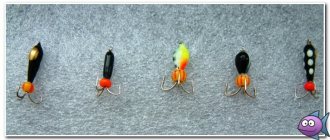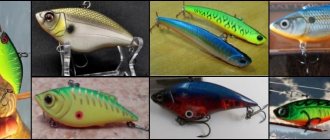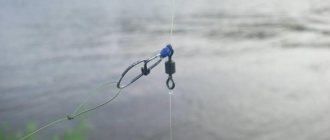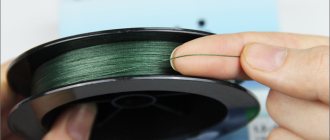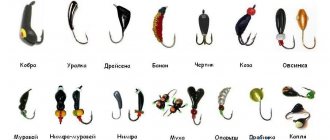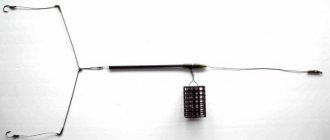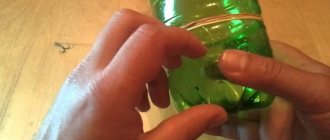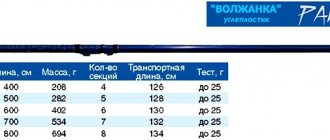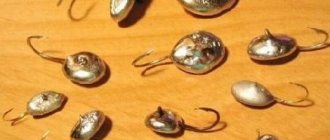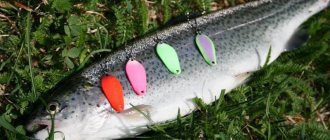What is a devil?
A devil is an elongated jig with a small soldered or hanging tee at the bottom, designed for vertical play. Various forms and modifications of this bait have been developed. The prototype of such a jig in the 60s of the last century was the sea bait “bug” by V. Zakharov from Magadan. Since then, devils have become a separate area of winter fishing. Some sources claim that this jig resembles the amphipod crustacean in shape and movements in the water, which is why this bait attracts fish so well.
Despite the apparent simplicity of fishing with this tackle, beginners do not always manage to successfully master it right away. This happens due to the initial lack of important details in the tactics:
- Fishing with a devil requires fine adjustment of the nod to the weight of the bait.
- In your arsenal you need to have a set of pre-configured and equipped fishing rods with different shapes and weights.
- When fishing, bait options are used (on already prepared fishing rods) until a worker under these conditions is found.
- The proverb “the legs feed the wolf” is just right for winter fishing with a no-attachment devil jig.
- You need to master several ways of playing perfectly. Often bites occur precisely during a pause or during a sudden change in the game or the pace of the retrieve.
This article outlines how to fish for devil in winter, choose the right bait and set up your fishing rods. Some secrets and nuances of such fishing are considered.
Fishing for devils in winter
Fishing with a reelless jig, which includes “devils” (devils), during the period of first ice and last ice, is usually more effective than fishing with classic jigs using baits. Catching perch with devil in winter, as a rule, turns out to be very productive.
Various types of “reelless” lures perform well when catching a wide variety of fish, but especially roach, bream, and silver bream. But, among the many types of reelless jigs, there are also those that are better at catching predatory fish - perch, bersh and pike perch. Devil is one of the best and most effective winter baits for catching perch.
Varieties of mothless moths
Reelless jigs, conditionally, can be divided into two types:
- Jigs are elongated, drop-shaped with a single hook equipped with cambrics, beads or hairs (droplet, Ural, ant).
- Jigs are usually equipped with a soldered double or triple hook (devils, goats), or suspended ones (witch, fool).
It is difficult to clearly classify any fishing lures, because... in their different types, the same properties or characteristics may overlap. So in the case of winter jigs, it is not easy to understand whether it is a reelless jig or a jig for fishing with bloodworms.
- For example, a devil can be either with a soldered or suspended treble hook, and with a jig of the “droplet” or “uralka” type, you can fish (and most importantly catch!), both without attaching a bloodworm, and with it.
- Not to mention the fact that, for example, little devils have their own varieties.
- Only amateur fishermen can afford to fish with jigs with a double or triple hook, and unless this is clearly prohibited by the rules, which may vary for regions. Athletes, as reelless jigs, use ordinary, often modernized jigs, with one hook.
- For a fish, the human craving for order is not at all interesting. There, under the ice, in the twilight, she is able to distinguish only the silhouette of the jig, its movements and the sound it makes. The success of fishing with a reelless jig largely depends on the angler’s ability to select the desired amplitude, intensity of vibrations and the nature of the “game” of a particular jig.
We have already described some of the techniques for playing with different types of jigs, but often, especially novice fishermen, trying to strictly follow even logical recommendations, find themselves in a situation where it seems that this whole theory is simply useless.
To prevent this from happening, you need to understand that the same jig at different depths and current strengths behaves completely differently, and the fisherman needs to select the right bait each time and find “his” game.
Source: https://Winter-Fishing.ru/fishing-tackle/chertiki-kozy-i-vedmy/lovlya-na-chertika-zimoy/
Reelless fishing
Fishing with a devil is a separate direction of ice-free fishing. Winter fishing for devils involves active movement and search for fish. Instead of bloodworms, devils for winter fishing are equipped with artificial bright elements that attract fish and act as an attack point. How to fish for the devil in winter? Let's take a closer look at the jigs themselves, the gear for them, tactics and fishing techniques.
Varieties of devils
If the bait has a quadruple hook instead of a tee, it is no longer called a devil, but a witch. Winter fishing for witches, as well as for devils, requires the use of special fishing tactics. There are also bait options on sale that have different weights. As a rule, the average weight of this devil is about 2 grams.
Devils can be divided into two main types according to body shape; these are baits with an oblong body and variants with a round body. The oblong ones are also called elongated, they can be used for catching all types of white fish, they are considered universal, but the round nozzle is used in cases where it is necessary to find a perch.
In the standard version, the color of the bait is black, which is also the most popular for fishing for devils in winter, but on sale you can find versions of this tackle that have a red, golden, or silver colored body. Depending on preferences, each fisherman himself chooses the most suitable option for him.
Form
Devils for winter fishing differ in the shape of the body of the jig. There are three large groups:
- Elongated (columns, sticks, cones);
- Short (droplets, balls, pot-bellied);
- Relief (ants, nymphs, etc.)
These baits are made in large or small sizes, of different weights, straight or bent, solid or with a non-ferrous metal plate. Large ones are used for catching pike perch at great depths; they weigh up to tens of grams, and are more likely to be winter lures than jigs. The body of the devil can be one-piece or two-part. Composite ones provide a kind of wiring. Some look like micro-spinners.
The classic fishing feature is cone-shaped, thickened and rounded at the top. The jig can be painted in various colors. Black or lead (no color) is considered a classic. White, red or other colors are less commonly used. Differences in shape give different play.
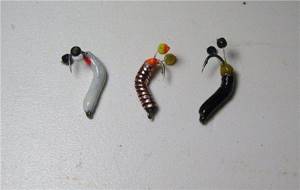
Bent devils
Tying to a fishing line
According to experienced devil hunters, the correct binding is in a vertical hole through the body using a hook. These are the devils of the famous expert on them, Andrei Kalachev. Occasionally, such baits are found in stores. More often they are made independently or to order. This connection gives the correct game. Kalachev’s little devil, in the opinion of many, is the most catchy and “correct”; when used skillfully and under the right fishing circumstances, it “mows down” the fish from the hole.
Standard methods of tying are by a ring or through a horizontal hole in the case (as in ordinary jigs). Some baits with a jig-type tying method provide suspension at an angle to the vertical, which gives a special, nodding game.
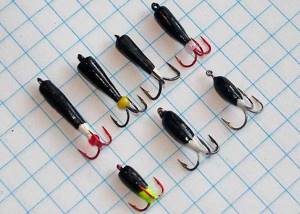
With a ring
Hook attachment
The three-pieces on the devils are often firmly sealed into the body of the bait. This is the standard option. Less common are models with a hanging hook, which make additional movements when retrieving (devils). There are models with several single hooks, each of which is loosely attached to the body. These are jellyfish (or witches). The bait, which is something between the devil and the uralka - goat, has two hooks soldered into the body. With soldered tees With hanging tee (demon) Medusa (bastard, witch)
Decorations
The most important part of the feature is that the various colorful devices on the hooks, which directly affect the interest and irritation of the fish, are the point of attack. These are various balls, cambrics, beads, threads, etc. Common colors used are white, red, yellow, orange and dark green. An interesting nuance that often brings bites is the placement of the bead above the bait freely on the fishing line. When playing, it moves, attracts fish with its color and tapping on the body of the jig. It is impossible to say unequivocally which color works best for a particular fish - this is a matter of experimentation during fishing. But I often find information on the Internet that white and dark green beads work well for roach, and red and yellow beads for perch. At great depths and at night, drops of phosphorus varnish on a tee work well.
Experienced fishermen have a whole arsenal of different features and fishing rods pre-configured for them. Beginners are recommended to start with standard solid jigs, having several black and lead models of different weights with different colored decorations (accordingly, already fully configured tackle, so as not to have to do this on the pond). During the fishing process, you need to go through the same holes with different equipment, changing the fishing methods, until the most catchy bunch is identified.
Devils for winter fishing
Now there are a huge number of varieties of this bait, but its main principle is the presence of several hooks (mostly three) and an oblong sinker. The photo shows three main types of devils for winter fishing .
- This bait weighs at least one gram. More elongated “devils” are used in reservoirs where there is weak or no current. Lures with a round weight are used for fishing in currents . Most often on large fast rivers.
- The color of the devils also varies greatly, but this does not have a decisive effect on the fish. As a rule, the most common bait color is black . The rest are selected not so much according to the taste of the fish, but rather according to the preferences of the fisherman.
- More important for fish is the shape and size of the “devils”. Plastic or foam multi-colored beads can be strung onto hooks to attract more attention.
- This type of “devils” is not very suitable for fishing for perch or roach, although if there is no alternative, then this fish will bite on such bait. Still, for perch and roach it is better to use “devils” of a slightly different type.
- These are classic perch “devils” , which this fish bites very actively on. Lures with shiny weights are especially effective. Roaches do not disdain them either, although pea-shaped “devils” such as those in the photo on the right are more suitable for this fish.
In principle, any bait of this type can work effectively for different fish. The main thing in this fishing method is not the shape and color of the bait, but its action. And this can only be achieved through the efforts of the fisherman himself.
Fishing rod
To successfully fish for devil you will need a rod approximately 40 centimeters long . This is necessary in order to make wiring convenient. This way, you can work effectively without leaving your box. A longer rod will be heavy, and your hand will get tired from constant work.
It needs to be equipped with a nod of about 10-15 centimeters, which will allow the bait to play effectively. The fishing line should be used as thin as possible , but adjusted to the size of the intended fish.
The rod must have a reel on it in order to be able to quickly reel in the fishing line when moving from one hole to another.
Fishing for bream and roach
The most important point when catching any fish with this bait is its play in the water column. Experienced anglers often change their fishing style and speed and are constantly trying something new.
In addition, it is recommended to constantly try fishing with different baits and look for the ideal one for a particular body of water.
Bream and roach are caught mainly at a depth of 2 meters or more , and this feature must be taken into account when choosing a place. Ideally, it would be some kind of hole.
The point of baitless fishing is to tease this fish and force it to grab the offered bait. Therefore, various combinations work effectively, alternating smooth and fast lifting.
Let's look at the classic wiring for bream and roach using a "devil":
- We lower the bait into the hole and let it freely reach the bottom. You should not make any sudden movements , otherwise you may scare away the fish.
- After the “devil” has sunk to the bottom, we begin to lift it up 50 centimeters , while performing oscillations using a nod with a large amplitude.
- Having reached the top point, we stop for a few seconds and again let the bait fall freely to the bottom. At this moment, the bite most often follows.
- We perform this operation three to ten times. If it doesn’t work , then we change the hole or fishing tactics.
- We try to alternate a smooth rise with a sharp one. Usually three series of several runs are enough to determine the presence of fish.
The main thing when catching bream and roach with the devil is constant practice and changing tactics, and only with experience comes real skill; the video will demonstrate practical catching skills.
Perch fishing
To successfully hunt this predator, you must first find a suitable place for this. If bream stays mainly in holes, then perch prefers places where there are a lot of flooded trees and branches. The ideal depth for this fish is about 2 meters .
- When you have found a suitable place, you need to feed the fish . This can be done by dropping a pinch of bloodworms into the hole. You should throw it up periodically to keep the fish in the fishing spot.
- Unlike bream, which loves smooth and leisurely movements, perch prefers a more frisky action of the bait. Constant twitching and lowering , changing the pace and style of play - this is the standard set of movements when catching this fish. You have to try everything.
- If it doesn’t bite in one place, you need to change the place and so on. Catching perch on the “devil” means searching for its location and truly sport fishing.
To summarize , we can say that this bait has gained great popularity among many fishermen. This especially applies to those who are not used to sitting in one place.
When mastering the correct wiring technique and gaining experience, the catchability of the “devils” can be simply incredible. Much more than a simple winter fishing rod with bait.
Source: https://lovum.ru/na-cherta.html
What kind of fishing rod should it be?
A fishing rod for fishing using devil bait is slightly different from a standard winter fishing rod and has certain requirements.
Rod
The basic requirements for a fishing rod are:
- A reel is required.
- It should be light in weight and have a comfortable handle.
- Must have an elongated nod with a certain rigidity.
- Must have a line from 0.08 to 0.14 mm
Such requirements are explained by the following fishing conditions. As a rule, winter fishing using a devil is a fairly mobile activity; you don’t need to sit near one hole and wait for fish, but look for it in different places. It is for this purpose that the tackle needs to be easily assembled and disassembled; a reel fishing rod is the most suitable option. Fishing enthusiasts use a balalaika-type fishing rod to fish for devils in winter. They explain this by the fact that it is convenient to hold, it has a reel and, moreover, snow does not stick to it, which is also very convenient in extreme fishing conditions. The reel on a winter fishing rod should work without any complaints.
Whip
The ideal option is carbon fiber (light and durable), you can use fiberglass or textolite. The average one is made of good, flexible and unbreakable plastic. The worst option is cheap plastic, which breaks under the slightest load.
Checking the whip is not difficult. To do this, you need to bend it with your hands so that the ends are relative to each other at an angle of 90°. And see how the whip “feels” at the same time. If it's not broken, it'll be fine. And if he is able to bend further, even better.
Nod
The nod should be, as already described above, a special elongated one. This design of the nod is necessary to ensure the required amplitude of vibration of the bait. Also, a long nod smooths out incorrect movements of the novice fisherman’s hand.
The nod material should not change its performance properties under the influence of negative temperatures. The most popular are metal nods, but what about lavsan options with a length of 15 - 20 centimeters.
If necessary, the nod can be bent at the required angle. This is done to specifically adjust the fishing rod to suit you.
fishing line
A fishing line with a maximum cross-section of 0.14 mm is required to ensure the transmission of vibrations from the fishing rod to the devil. Thicker versions of the fishing line exhibit poor oscillations due to increased friction with the water. The fishing line can be used either monofilament or braided, depending on who you like.
It is precisely because when using the devil tackle, the fishing rod is equipped with a thin fishing line, and there is no possibility of installing a leash, it is impossible to catch a pike with this tackle. The toothy predator simply cuts off the devil when attacking, because it has very sharp teeth. From the stories of experienced fishing masters using such gear as the devil, it is known that of the predatory fish you can catch perch and pike perch with it, but no one has caught pike.
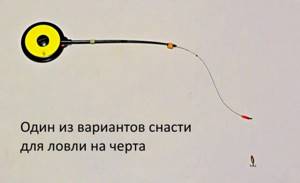
Photo 2. The balalaika is quite suitable for the devil.
Knots for tying a devil with an eye to a fishing line
To tie the devil with an eye to the fishing line, we use the usual knots for hooks with a ring.
Palomar knot:
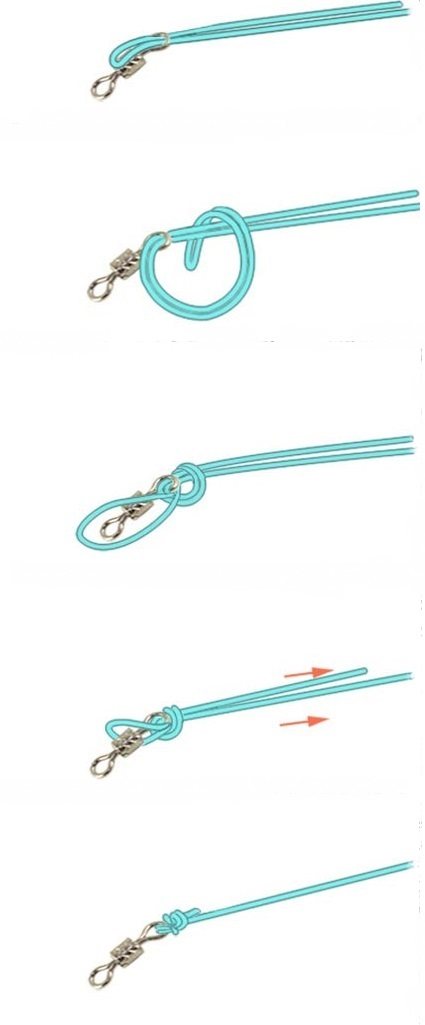
Palomar
Clinch and reinforced clinch:
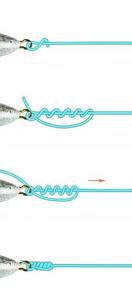
Clinch knot
To make a stronger clinch, the fishing line is also threaded into a large loop:
Strengthened clinch
How to properly tie a devil to a fishing line without an eye
Standard bayonet assembly.
The fishing line is threaded through the hole in the devil and tied to the hook. To tie a devil with a through hole (Kalachev), the same knots are used.
In addition to one devil, a rig with the addition of a second jig on top is often used. This type of installation is called a steam locomotive (combi, tandem). Some fishermen claim that a locomotive made of two devils works better than one bait. But there is a drawback to using it - when fishing for large or active fish, the tee of the second one often clings to the lower edge of the hole, which is why a derailment occurs.
Making devils
Everyone knows the devil. However, it is not always possible to find suitable models on sale and many novice fishermen are forced to fish with what stores offer them. This may be one of the reasons for unsuccessful fishing trips and disappointments in the fishing method.
Some fishermen manage to catch well using purchased devils.
In my opinion, this happens mainly against the background of high fish activity and, most often, during first ice. Having caught it with an ordinary jig with a nozzle, anglers put it aside and take out a devil for testing: if there is a “distribution” of perch, it can grab anything, as long as it plays at least tolerably well. The individual successes of such experimenters in baitless fishing pale in comparison to the large number of failed attempts to catch devils during periods of average or poor bite, especially when the bite on an ordinary jig with bloodworms is tolerable. And if you take into account changing places and catching other types of fish, then the number of such accidental successes can be counted on one hand.
There are several examples from the practice of novice “draftsmen”. These people went with me to “extracurricular activities.” The fishing locations varied greatly in depth, presence and strength of current, as well as the species composition of fish in the catches.
The main fishing targets were perch in Lake Ladoga and white bream in the Gulf of Finland. When catching bream, there was a significant bycatch of roach, silver bream, ruffe, and sometimes pike perch flew in too. Sometimes the bycatch became the main catch until a school of bream approached. On Ladoga, it often happened that schools of small and large perches were caught. It was also possible to filter larger perch by working with the selection of devils while actively fishing in a large school of fish. In the above conditions, a small set of 2-3 devils was needed, assembled and configured at home.
Most beginners are inclined to believe that just give them the right tackle and, based on what they have read and observed, they will immediately begin to catch all types of baitless jigs. On these trips, I happened to observe a series of typical mistakes made by beginners. First, let's try to deal with the most obvious. All the beginners fished with purchased devils, chosen to their taste. Before one of the fishing trips, I assembled a “locomotive” rig for my friend from homemade devils, and he began to fish much better with it. At the same time, the fishing rod, the nod, and, accordingly, the game remained the same.
When choosing where to start assembling your tackle, taking into account all the variety of nods and fishing rods, the first thing you should pay attention to is the bait. After all, it was the devil who gave the name to the whole type of baitless fishing, and it is with the acquisition of the wrong devil that fishermen, as a rule, begin to take their first steps in this area.
An analysis of the advantages and disadvantages of tungsten devils, which our shelves are full of in abundance, is worthy of a separate topic. Let me refer to the publications of authoritative “devils” in various publications. Most of them, like me, fish with homemade devils made of solder or lead. Only the manufacturing nuances may differ.
And the most important thing, but not obvious, is the specialization of the devil, which fishermen lay down when making it. For example, someone catches mainly bream and, as a result of trial and error, comes to certain proportions of devils with which he is good at catching this particular fish. Some fisherman try to make a more universal bait because he is too lazy to change fishing rods, but in the end it turns out that his bait catches noticeably worse in comparison with fishing with a special devil when targeting a certain type of fish. But such an angler catches everything and this is his real advantage over the “narrow specialist”.
A clear example of underestimating the specialization of the little devil can be the cases of using this bait only when searching for fish, followed by its replacement with a reelless jig after discovering a school. The obvious disadvantage is the loss of time choosing a suitable rewinder and selecting the right game. During a short winter day, all these transitions between gear can be successfully used only by experienced bleeders. They have a lot of pre-prepared fishing rods for different conditions, and they have enough experience to instantly select the right game. However, when traveling to an unfamiliar body of water, such tactics can fail even experienced fishermen.
Almost any angler who knows how to use a soldering iron at least somehow or is stubborn enough to learn how to make 10 or even 20 catchy devils in 2–3 hours can make them. The skills required for this “sacred activity” are at the level of labor lessons in elementary school.
For fishermen who have decided to master devil fishing, I offer a simple method of making catchy baits, which I have tested in the reservoirs of the North-Western region, mainly on Lake Ladoga and the Gulf of Finland. However, you can make baits specifically for your favorite places and types of fish.
Introductory instructions to the process
First, let's try to make a classic devil. A classic, according to the generally accepted opinion of nozzle-less people, is considered to be a devil made of lead or solder. Based on this devil, you can make a composite devil for catching predators at depth.
Some fishermen make devils with four hooks. For such devils, I do not yet have significant fishing experience and sufficient statistics to somehow indicate their advantages or disadvantages. But as an option they are worth mentioning. We cannot exclude the possibility that these baits will be more effective than ordinary devils under your fishing conditions.
Devil hooks
The main component will be a tee. This is the most important element on which depends how many fish you will catch on the ice and how many catches and idle hooks you will have “on the lips”.
Among products from different companies and even among different series of the same manufacturer, there may be differences in the sizes and shapes of hooks, so that even experienced fishermen sometimes get confused about their “anatomy”.
It will seem to many anglers that these little things are not worth significant attention, but in fact they will determine whether you can successfully fish with a devil or throw this bait due to the large number of trips and idle hooks. This is precisely why you need to take into account all these little things during production.
Hook sizes and approximate weights for classic devils
- To catch roach, hook sizes No. 18–20 are required according to the international classification. The mass of devils is 0.12–0.14 grams.
- To catch bream and bream, you will need numbers 16–18. Weight from 0.15 to 0.5 grams. This gap in weight is associated with the shape of the bodies of bream devils - they can be long and short. It is clear that it is better to catch small bream with a devil with the smallest hooks. But the body length of the devil may be longer - for the bream this is not as critical as for the roach. And it will be more convenient for you to fish with bait of greater weight.
- For catching large perch and pike perch, hook sizes are Nos. 6–14. The mass of the devil is from 0.35–4 g or more.
Such differences in the weight of devils are due to the shape of the baits and the weight of the materials used, but the proportions will be similar. To make the devil heavier, you can not only increase the size of his body, but also use solders with a maximum lead content.
When fishing for perch and bream using tungsten lures, a similar number of bites can be observed, but at the same time, the average size of the fish caught is reduced compared to fishing with devils made from lighter materials. The realization of bites also suffers somewhat, especially when catching passive fish, and this is the kind of fish we catch most often. The reason is the weak suction of the bait and too little draft of the water flow for the fish to confidently capture the heavy tungsten devil. Your nod will indicate a bite, but the hook will be empty.
During the practice of catching certain types of fish, a dependence of the frequency of escapes on the height of the hook was revealed. Hooks of the same number can have different hook heights. For greater accuracy, I will give the lengths of the sides of an equilateral triangle between the tips of the hooks on some devils, which are good for catching certain types of fish. This will help to additionally control the parameters of the product during the targeted production of devils of a certain specialization.
- Roach, small perch, small bream - 4–5 mm;
- medium bream, large roach, medium perch - 6–7 mm;
- bream, large bream, large perch - 8–9 mm.
For special perch devils, larger hooks can be used, with a distance between the tee tips of up to 11 mm. When deep-sea fishing for large perches and pike-perch, special “trophy” devils are made. They can be composite and have larger hooks.
Devil's body
The height and thickness of the devil's body is chosen at your discretion. The sizes of baits and hooks are based on the experience of using specific baits when fishing for perch on Lake Ladoga, as well as bream, bream and roach in the Gulf of Finland. For many small lakes, where the fish are often much smaller, the smallest versions of devils are useful.
I took into account the comments of the devil fishermen and I hope that this information will help you navigate when choosing a suitable model.
- Elongated devils catch bream and bream better. The body length is about 11–12 mm, sometimes it reaches 25 mm, while they are thin, about 2.5–3.5 mm in diameter.
- Short and medium-sized devils with the smallest hooks are good for roach; their length is usually from 6 to 12 mm. Roaches can also catch larger baits, but most often we catch not the largest fish, and not with the best bite. True, a little larger devil can cut off the little things. However, roach has a small mouth and is not at all predatory in nature, and therefore there are purely physiological restrictions on the size of the bait. From my own experience, I can add that roaches are often captivated by different color schemes. It makes sense to make dashes of black, dull metallic, orange, and white colors. A dim green or yellow glow-in-the-dark color will do a good job in heavy clouds or snowstorms when the light is quite low.
- For perch, devils with large tees with a body height slightly exceeding the distance between the hook tips are good. Such devils cut off small things, but we must take into account the average size of perch in a particular body of water. For Ladoga the devils will be larger, and for the Gulf of Finland they will be smaller. But in any case, for such devils you need tees with a short forend and a high hook, otherwise a large number of derailments cannot be avoided. The hooks should be large and the devil should be light. With the most careful bite of a perch, such a devil quickly flies into the perch’s mouth, and hooking in most cases is effective.
When fishing, it is useful to have several baits of a certain size. Many anglers forget that the devil is a consumable item, and this is another reason to learn how to make it yourself. Losses on hooks are easy to avoid if you have a simple unhook. For those who often get caught by an active bite, the wear of the hook tips will be relevant. Frequent snagging on the lower edge of the ice easily contributes to this.
In this regard, I recall a master class by a Japanese spinning rodist, a guru on trout fishing in commercial reservoirs, who said that he changes the hooks on a trout spoon after every fishing trip. There is no need to take things to the extreme, but it is still worth considering that after catching a couple of hundred “faced” perches, your little devil will lose fish a little more often.
Old dull hooks are especially problematic when catching bream and white bream. It often happens that the fish takes a pause at the end of the retrieve, and you detect it during the control hook. It is difficult to predict how long to pause and at what moment a bite may occur; in addition, such bites are not always noticeable. And it doesn’t cost the bream anything to try and spit out your little devil in a split second. The bait with the sharpest hooks simply “sticks” to the soft tissues of the fish’s mouth.
Manufacturing
- Accessories for devils:
- stranded copper wire from electrical wires, used to form the body of the bait;
- tees or single hooks.
- Consumables:
- solder;
- liquid soldering flux or paste;
- yellow or red silicone cambrics with a diameter of 2 mm;
- nail polish in black and white and a special fishing polish that glows in the dark.
- Technological equipment:
- board for soldering (on this board you can later install a pair of nails with a fishing line stretched between them to dry the painted little devils);
- hairpin - a piece of wire made of titanium or stainless steel. You can use tailor's pins or thin needles, heated until red and then released in the air. They should be covered with a dark layer of oxide, thanks to which the solder will not grab them.
- Tools: soldering iron, drill, tweezers, wire cutters, stationery knife.
Devils from single hooks
To make devils from single hooks (Table 1), you should select hooks with a bend without lateral deviation. The length of the fore-end matters: it is more convenient to make baits from hooks with a long fore-end. The eye of two hooks should be bitten off. Three hooks must be wrapped with one thin wire to secure the hooks together. Then you need to clamp the hooks into the drill chuck as evenly as possible.
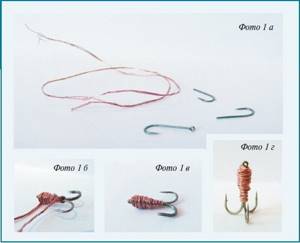
When making devils from single hooks, you can make an additional element - colored beads. Naturally, you put the beads on the hooks before you start winding. The best option in this case would be a little devil with an eye separately inserted into the workpiece. This is due to the fact that beads rarely have a hole large enough to immediately insert three hooks into it, one of which has an eyelet. But if you come across beads with a wide hole, this will simplify the process, since you can first insert a hook with an eye into the bead, and then add two more hooks with the eyes removed.
When making devils using the winding method, it is easy to give the baits the desired shape. This way you avoid unnecessary soldering and machining.
Devils from tees
The easiest way is to make a jack-of-all-trades (Table 2). The tee is wrapped with copper wire up to the eye, then treated with flux and soldered - that's all. If necessary, you can remove the deposits with a knife, and then paint the devil with black nail polish. It is not worth bringing the devil to perfect smoothness: the more you “lick” the surface of the devil, the higher the risk of touching the tips with the tool and dulling the hooks even before fishing. I can assure you that fish bite no worse on devils with a rough surface, and such defects can be easily hidden under a layer of varnish.
The devil can be made longer. To do this, bite off the eye of the tee approximately in the middle. Then you need to wind the wire using the hairpin as an extension. After the body of the devil is formed, the pin is carefully removed. In its place, insert the bitten eye of a tee or the bitten eye of a single hook, if there is a desire to make the eye smaller. The ear should fit into the devil's body with some effort and not fall out, even if the devil is turned over. This is necessary so that when soldering the little devil can be held with the hooks facing up, then the solder will take a drop-shaped shape.
You can make a little devil with a through hole for fishing line (Table 3). To do this, when forming the body, you should wrap the hairpin so that one end comes out at the top and the other at the bottom. Then you need to take the hook with tweezers and solder the devil’s body in the usual manner. After the solder has hardened, you need to remove the pin, and after processing and painting, clean the hole of the devil with it again.
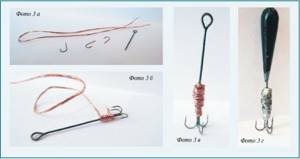
There was no significant difference in catchability between the devil with a loop and the devil with a through hole. A devil with a through hole is more difficult to manufacture. This is how the smallest devils for catching roach are made; they are also convenient to use in the “locomotive” rig.
Belief in the bait is very important, and if you are convinced that a certain type of devil is better, make it the way you like. While you are a beginner, you have a high faith factor, that is, your conviction in the correctness of something is not based on facts from your experience. Over time, you will gain experience and confidence.
However, jack-and-ears have one advantage. It can become decisive in some specific fishing conditions. If the devil with an eye is tied to the fishing line not with a tightly tightened knot, but with a loop (for example, a Rapala knot), then the bait will acquire a greater degree of freedom when playing. Considering that little things can make a big difference in a rewinder, it’s worth making such equipment.
Painting
Painting the devils begins with preparing the dryer. This is an ordinary board with two nails, between which a fishing line is stretched. You take the processed workpiece by the hook with tweezers and apply varnish to the devil’s body. After that, hang it on the dryer. After drying, you can apply another layer at the bottom of the devil with glow-in-the-dark varnish. After painting, you need to use a needle to clean the hole for the fishing line or the eye of the devil.
Decorations
Some manufacturers have multi-colored devils that often attract anglers more than fish. For sales you need a presentation. To effectively fish specifically for devils, you don’t need any extra decorations. Sometimes even bright color spots have to be removed to please the capricious fish. And when she is handed a nondescript little devil scraped with a knife, she suddenly begins to peck.
Once again about hooks
As for the color of the hooks, unambiguous confirmation of its effect on the bite has not yet been obtained. It can definitely be said that silver anodized hooks are more resistant to oxidation after fishing in the brackish water of the Gulf of Finland and do not rust, even when left stuck in a piece of polyurethane after fishing.
For white fish, you can use thin hooks. They are better at detecting fish with uncertain bites. Thicker hooks are suitable for perch, as it bites much more confidently than leucorrhoea. The hookiest and most durable hooks were made from Kamasan hooks with a round hook. For some reason, these hooks hold their edge longer than others. In general, it is recommended to use Japanese hooks and tees from well-known manufacturers, such as Owner or Gamakatsu. Maruto hooks performed well. Somewhere in the Russian outback they can be difficult to get. In this case, you can use a more affordable option - Cobra hooks. The loss of time and money spent on selecting and purchasing the right hooks pays off many times over.
Therefore, carefully select hooks and handle them carefully when making baits. Do not allow the tip to be soldered, avoid unnecessary mechanical surface treatments - this increases the risk of damage to the hook tips by the tool. Try to use a thin construction knife with replaceable blades if you need to clear out sagging. Keep the little devils pinned into the backing and change them as the hooks wear out.
Fishes that are caught with the “devil”
In principle, with a “devil” you can catch any fish for which the size of the bait is “too tough”. However, among the pond inhabitants, three species are clearly distinguished, which usually form the basis of the catches of fishermen.
Bream
I put this fish in first place, because catching bream with a “devil” is a serious alternative to other methods of winter fishing, including traditional ice-float fishing. And sometimes it happens that it is the active “shaking out” of the bream that turns out to be more effective than passive monitoring of the guard and floats. By the way, among bream fishermen, a kind of class of adherents of fishing with “devil” has even formed.
Bream are attracted by: a smooth low-frequency game at the very bottom, a leisurely rise of the bait and fairly long pauses, especially long in the dead of winter.
Perch
He also responds well to this bait. I wouldn’t mind responding - everyone knows how perch loves to rush at everything that moves. In catching this fish, in addition to the classic “devil” model, an elongated one is also used, and you can play with the bait not only according to the standard “jig” algorithm, but also twitch it briefly - like a spinner.
By the way, catching perch with a “devil” differs from other methods of catching this fish in some special romance.
Roach
Yes, not just any kind, but medium and large. A gram (lead) “devil” has some ability to sift out small roaches - not to mention larger models. The track responds to this bait perfectly. However, I don’t yet know anything about fishermen who specifically engage in catching roach with the “devil”. At least in my circle, all the “devils” are, without exception, breamers. For them, roach is still a kind of by-catch.
Other fish
Of the other representatives of the ichthyofauna, the “devil” came across: rotan, ruff, pike perch (small), bleak, dace, chub, ide, crucian carp, grayling and even pike. There is no information about catching burbot with a “devil”, although according to all estimates, it should bite on it (especially on a large, heavy one - so that you can knock on the bottom, and - with a nozzle).
Basic fishing styles
To start the game, lower the bait to the bottom. To attract the attention of the fish, we tap the bottom 5 times and begin a slow rise with a small amplitude but a fast frequency. Raising it to a height of 40 cm, we make a smooth hook and lower the “devil” back to the bottom. With this style, the bite will not take long to arrive.
The second style of calf is called the pendulum. The nod is in a horizontal position. Having lowered the jig into the hole, we carry out a slow rise, while moving the nod to the right and left (one swing). Having made quick 5-6 swings, we lift by 60-70 cm. Then we repeat everything from the beginning.
For the third style, the nod is placed at an angle of 45°. By lowering the “devil” we make smooth wiring with increased amplitude. Every 20 cm we stop for a 3 second pause. The lift ends with a smooth sweep.
How to make it yourself
Although the trade offers anglers a wide range of “devils,” many ice fishing enthusiasts prefer to make their own bait. This is a fairly easy task
within the capabilities of many fishermen.
In addition, homemade “devils” can be more catchy
, since their manufacturer embodies in his work his own vision of the necessary properties that, in his opinion, the bait should have.
Making a large batch of “devils” will save a significant part of the family budget.
To make a “devil” at home, you need the following materials and tools:
- tin or lead and a container for melting them;
- required number of hooks - three per bait;
- beads;
- copper wire;
- wooden block;
- cold welding;
- needle file;
- soldering iron;
- aluminium foil.
When making a “devil”, you should follow the following step-by-step instructions:
- The ears of two of the three hooks are bitten off and the places are cleared for subsequent soldering. Long shank hooks should be used.
- Three cuts up to 3 mm deep are made on a wooden block at an angle of 120 degrees to each other.
- Hooks are inserted into the slits with the shank up.
- The hooks are connected to each other using a thin wire at the soldering site.
- A cone-shaped funnel made of foil is placed on the hooks so that the cone is located on top of the fore-end.
- Molten lead or tin is poured into the middle of the funnel. The funnel is completely filled.
- The ring for attaching the fishing line is inserted into the middle of the mold before pouring.
- After cooling, the “devil” is removed from the mold and processed with a file, giving it the desired shape.
Interesting!
Most “devils” are traditionally painted black. Experimenting with painting bait red or yellow can lead to unexpected results and help increase the catchability of the bait.
Soldering a tee and a few more ways to make devils with your own hands
The basis of the bait when making a homemade devil for winter fishing is a tee. For smaller devils, the correct treble (small thin hooks, long shank) is difficult to find in the store. More often than not you have to solder it yourself. This preparation is the first step for various methods of making a devil in the future. It can be poured into a mold with lead, or solder can be manually soldered on top.
Materials:
- Hooks;
- Copper wire;
- Soldering iron, solder;
- Cork or drill (to hold hooks);
- Bead (if desired).
We bite off the rings of two hooks, leaving the third. You can bite off all three at the ring, and the fourth, on the contrary, at the bend, and then insert it into the middle between the first three (to get a devil ring. The hooks need to be tinned and secured in the correct position (in the drill head or in the cork (using pre-made cuts) Then we wrap the workpiece with tinned wire and solder it. The workpiece can be processed with a needle file.
Devil's body
All further manipulations depend on variations in the attachment of the devil’s body to the workpiece. You can do this in several ways:
- Solder by hand.
- Pour through the mold (more about pouring below).
- Solder a copper or brass crown on one side (more on this later).
- Prepare blanks from a lead plate and solder them on both sides.
When manually soldered (filled) with tin, lighter and more voluminous devils are obtained; they are intended for fishing at depths of up to 5 meters with weak or no current. For greater depth or flow, it is better to use lead. By using copper or tungsten wire and adjusting its quantity, the correct weight is selected. This can also be done by winding tin-lead solder. The workpiece is wound and soldered until the required shape, weight and size are obtained, and then processed with a file.
The tee can be soldered into a lead sinker (olive or pellet). If you do this with two pellets, you will get a devil ant (snowman). Then the devil is processed with a file and painted.
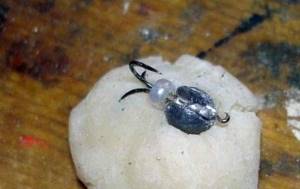
Making a devil's jig with your own hands
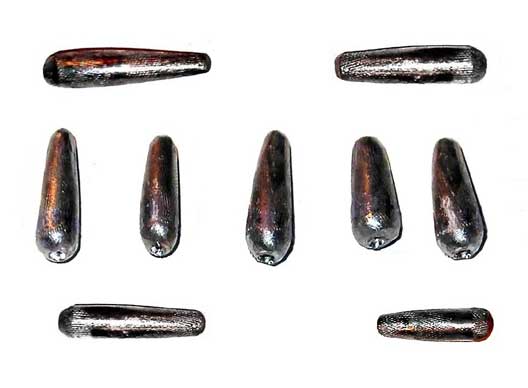
To make devils with your own hands, we cut or file the ends of the jig blanks, roll out the lead blanks again, giving them the desired round or conical shape (see photo). For these purposes, I use a wide file with a well-ground notch.
Next, we pierce blind holes about 5 mm deep at both ends of the finished devil bodies for soldering loops and tees into homemade unwinding jigs.
Loop for attaching the devil to the fishing line
You can also make a loop for attaching (tying) the devil to the fishing line and swiveling the jig with a tee with your own hands by bending a 0.8-1 mm thick tinned copper wire around a nail of a suitable diameter. Then the antennae of the loop are bitten off to a length of 4-5 mm and twisted.
Hinged hook mount
If you decide to make a hinged connection of the tee with the body of the jig when making your own devil, then before twisting the antennae of the loop, insert the tee into the loop. See photo.
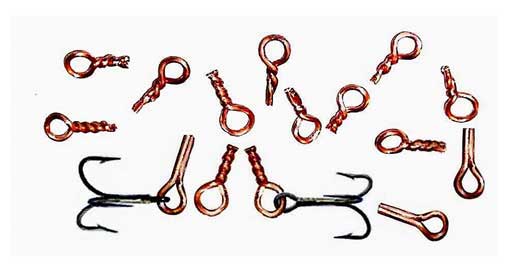
After soldering the loops into our blind holes and painting the bodies of homemade jigs, we should end up with something similar to what is shown in the photo above, made for fishing with hinged tees with jig bodies.
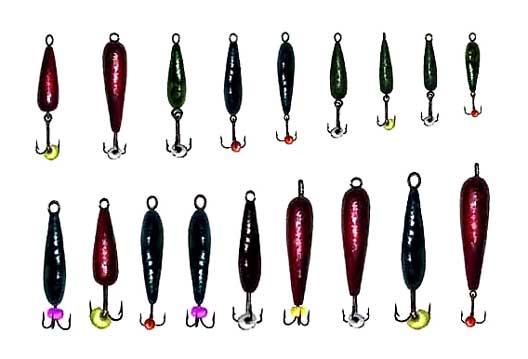
Aligning the jig vertically
By bending the top loop away from the center, the devil suspended on a fishing line can be given a slightly different position in space. That is, align it vertically, or give the fishing devil a slightly inclined position.
A word of caution. In order to save time spent making vertical jigs with your own hands, I do not recommend soldering tees for devils from single hooks.
In addition, when buying tees, make sure that they are soldered together with copper, otherwise I came across treble hooks soldered with who knows what, which fell apart when heated with a soldering iron.
How to make a devil on a pike perch?
Pike perch is a rather cautious fish, so it is necessary to prepare the devil for catching this species as carefully as possible.
In principle, the starting materials will be the same, the production technology will be slightly different:
- Hooks are taken with a longer shank so that the tee of them is as even and correct as possible;
- on a block made of wood , which should be at an angle of approximately 120 degrees. The depth of each of the cuts should be about 4 mm;
- The hooks are inserted there and tightly wound with wire;
- Take ordinary culinary foil , make a small funnel out of it and pull it onto the hooks so that the cone is located at the top of the forend;
- Pour melted foil into the foil . This is done very carefully so that the entire mold is filled with metal as evenly as possible;
- Before the metal has time to completely harden , a ring is inserted into it, which will be used to secure the fishing line;
- After the mold has hardened , the foil is removed and they begin to form the body of the bait, doing this with a small file. At the last stage, the nozzle is painted.
Fishing tackle
Tackle for catching devils consists of the following elements:
- Fishing rod. The most convenient way to catch devils is with a balalaika fishing rod. It has a fairly short whip, it fits well in the hand, and with its help it is comfortable to perform the required animation of the bait.
- Fishing line. When fishing for devils, use monofilament line or fluorocarbon. When fishing with any reelless bait, thick fishing line is not used, since the necessary play can be given to the bait only with thin fishing line. The maximum line diameter is 0.14 mm.
- Nod. The nod is perhaps the most important part of the tackle for catching devils. It is the movements of the nod that give the jig the game of the required frequency. Various nods are used for catching devils (photo 3). They are made from clock spring or lavsan. The correct nod should be conical, i.e. it should taper towards the end in both thickness and width. The correct body kit for the nod is slightly below the horizontal under load and at an angle of 15-20 degrees above the horizontal without load. The length of the nod when fishing with a devil is approximately 20 centimeters.
- Hooks. Hooks on devils can be made of thin and thicker wire. The latter are used when fishing for bream and, oddly enough, when fishing for perch, since the thin wire cuts the delicate lips of the perch.
Expert opinion
Knipovich Nikolai Mikhailovich
Zoologist, hydrobiologist. I am interested in fishing at a professional level.
Attention! Experienced fishermen take several fishing rods with them when fishing. Each of them has devils of different weights and nods tuned specifically for these baits.
Homemade soldered devil
To quickly get such bait at home, you will need to use the following tools and materials:
- Miniature bench vise;
- Standard drill chuck;
- A soldering iron with a thin tip, the maximum operating power of which will be 40 W;
- Wire cutters;
- Pliers;
- Soldering acid;
- A small brush with which the acid will be applied;
- Tin or lead solder, as well as rosin;
- Copper wire, the diameter of which should be about 0.2-0.3 mm;
- Several identical fishing hooks, their size should be from 2.5 to 5.
First, they take three hooks and carefully examine them: from them, choose one with the most neat eye, leave it, and bite off the other two. Through this eyelet the bait will be attached to the fishing line. You should bite off the two remaining ears as far as possible from the hook itself.
It is most convenient to make them of different lengths, since in the future this will greatly facilitate the work.
The hooks must be firmly clamped in a vice, but this must be done very carefully so that they do not bend. First, one of them is wrapped with copper wire, as tightly as possible. This will allow the solder to adhere better to the resulting product in the future.
After this, the hooks are connected to each other using the same copper wire.
The correct fastening is established using a drill chuck: the workpiece is clamped between the jaws, carefully leveled in height and the chuck is thoroughly tightened.
The body of the future bait will be formed using copper wire - it will be tightly wound around the hooks as follows:
- The first turns must go from the bend to the eye ; they are pressed together as tightly as possible with pliers or by hand;
- From the eyelet, the turns are applied approximately to the middle , after which they move in the opposite direction;
- The excess wire will need to be bitten off or broken.
When the workpiece is made, proceed to soldering. Use a brush to lubricate all elements with soldering acid and apply tin or lead. It is imperative to wait until it cools down, otherwise there is a risk of getting a rather serious burn.
You will need to solder it at least one more time: the devil is returned to the cartridge, securing it at the very tip.
At the last stage, using a soldering iron, you need to give the devil the correct shape. Using a file or other similar product, the rosin is completely cleaned off, and a black thread is wound around the forend. If you wish, you can paint this nozzle in a suitable color. It is generally accepted that fish bite much better on devils painted black.
This method has a rather serious disadvantage: there is no way to get a bait with beads that will not fly off the hooks. Therefore, they need to be put on after the product is completely ready. You can even secure the beads with small pieces of cambric.
What to make a devil out of?
Making such a nozzle with your own hands is not too difficult, and it is made from scrap materials. To do this, you will have to take three identical hooks, saw off or bite off the eye of two of them, press them tightly together and twist them securely using thin copper wire.
After this, take an ordinary drill, the chuck of which is equipped with a three-jaw mechanism, clamp the hooks between the jaws, after which they are carefully soldered with tin or lead. This completes the production of the tee.
Two strips of the required size are cut from sheet lead, cuts are made in them for hooks and a tee is soldered to them. First you need to solder only one strip , make sure that the hooks hold on to it quite firmly, after which they are connected to another plate.
All excess is cleaned off with a file or needle file, and sanded thoroughly to make the product shiny. Now all that remains is to paint and dry the product, after which the product can be considered completely finished.
"Lazy" homemade devils
Such nozzles are distinguished by the fact that they are much easier to make, since you do not have to resort to soldering; accordingly, there is no need to remove rosin and other substances from the surface of the finished product, which in one way or another can reduce the catchability of the product.
The easiest way to make such devils is from parts from lighters, since even the cheapest design has several elements that can be useful:
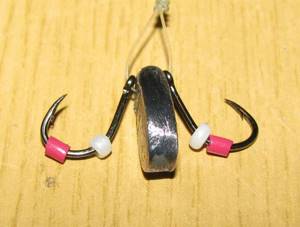
- Small springs , with which you can protect rubber elements from being cut by fishing line during fishing;
- Felt mugs , which are put on the forend of the nozzle, act as a wing, providing natural guidance in the water column;
- Cylinders made of yellow alloys - they are just suitable for the production of the nozzle body;
- Metal rods , made of yellow alloys, have a longitudinal hole. They are also suitable for getting the base of the devil's body;
- Soft aluminum tubes.
The hardest thing here is to carefully break the lighter. To do this, wrap it in a rag and gently hit the plastic part with a hammer. The cylinder is removed, into which the compressed lead pellet is inserted. A hole is pressed into it with a hot needle.
A small piece of a rather soft tube is put on it, through which the hook will be threaded. In principle, the nozzle is ready for immediate use. To make it as visible as possible, it is wrapped with copper wire.
How to catch perch with a “devil”
Winter fishing. Large perch on a homemade devil.
A bait can be characterized as catchy only if the angler learns how to use it correctly. The bait itself, thrown into the hole, is a small piece of metal with a tee. But if you learn to control this piece of metal, that is, to carry out the correct wiring, then it will already be an effective bait for catching perch. Only with the right game, when the bait begins to imitate a living organism with its movements, can you count on a serious catch.
The game of the “devil” is similar to the game of a spinner, the only difference is that these movements are directed either downwards or upwards. For perch, chaotic and fast movements are what you need. The “devil” moves from the bottom of the reservoir and closer to the surface. At the same time, the jig is tossed with a fishing rod, after which it sinks to the bottom. If there are no bites, then the movements are repeated.
When the bait moves upward, it should be animated with a nod. If you do not do this, then perch or other fish may recognize that the bait is not edible, and then you should not count on bites. At the slightest bite, which can be detected by a nod, you should immediately hook, otherwise the fish may not catch the hook.
During the game, you should constantly experiment, changing the nature of the “devil’s” movements, making them either fast or slow, while lengthening or shortening the pauses between movements.
If there is no bite, then it makes sense to fish all layers of water, since the fish can be on any horizon. If this does not help, then it is better not to waste time, but move on to the next hole. Fishing in winter is hard work when you have to drill hole after hole in search of fish.
